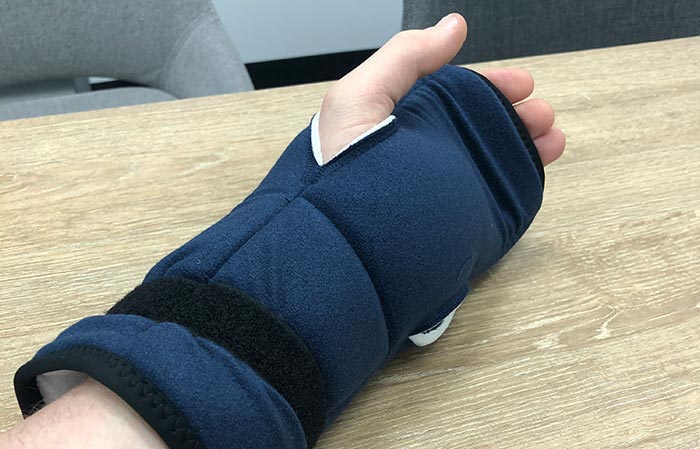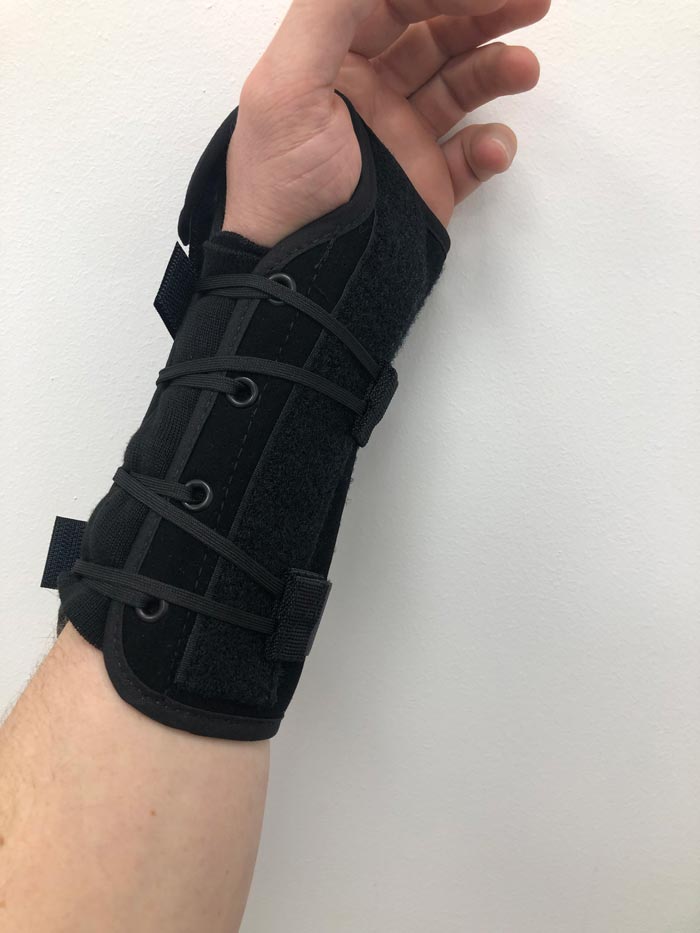
Recently, we had the pleasure of having Sylwia, a final-year Master of OT student from Flinders University, Adelaide. She spent 8 weeks with us observing and learning all about the art and science of hand therapy and integrating her theoretical knowledge into practical healthcare skills. She embarked on a small project to look at what constitutes the best carpal tunnel splint or brace which can be an important factor when experiencing carpal tunnel syndrome. This is her work:
Multiple options exist in the marketplace, and many patients experiencing carpal tunnel symptoms are eager to try wrist splints as a conservative measure. The terms ‘brace’ and ‘splint’ are generally interchangeable; however a brace is usually made of soft material and a splint is made of thermoplastic or harder substances. A splint can be custom-made and moulded to the shape of your hand by a hand therapist while a brace can be purchased either at the hand therapy clinic or pharmacy (Page et al., 2012).
The reason for bracing or splinting for carpal tunnel syndrome is to reduce pain and swelling, prevent excessive wrist movements particularly during the night when we tend to flex or extend our wrists without any control (Howell et al., 2022). Those movements cause pressure build-up within the carpal tunnel, which impacts the median nerve running within (Weiss et al., 1995). Tingling fingers, numbness or pins and needles after waking up is related to the compressing of the median nerve within the carpal tunnel. Shaking the hand off usually helps with the symptoms, as by doing so, we release the pressure from prolonged wrist bending which naturally occurs during the night (Sharrack & Das, 2021). However, with time those symptoms can become more prominent and last a lot longer. People with mild to moderate carpal tunnel symptoms often benefit from a nighttime wrist splint (Manente et al., 2001.) People with acute and severe symptoms may benefit from use of a daytime brace like this one pictured below for a short period of a few weeks during repetitive wrist activity.

When selecting an appropriate brace or splint for your carpal tunnel syndrome symptoms, there are multiple factors which need to be taken into consideration:
Angle of the splint? Evidence shows that your wrist should be placed in a neutral position (which is having your wrist straight). This will prevent bending the wrist forwards or backwards, causing extra pressure within the carpal tunnel structure.
Metal or plastic internal supports? Often braces have a thin metal or a hard plastic bar running on the palm side of the brace. This can be uncomfortable depending on the design and fit of the brace. The metal component may sit right over your carpal tunnel possibly creating further pressure to the area. Rather than helping with the symptoms it potentially could add to them.
Fingers included or not? Many of the commercially available splints / braces to purchase don’t include supporting the knuckles. When we bend our fingers (often at nights), there is a muscle called the lumbrical muscle deep in the hand that can contract and cause increased pressure into the carpal tunnel. A recent study (Mohammed et al, 2022), revealed that close to 80% of people have lumbrical muscles penetrating into the carpal tunnel when fingers were in a fully flexed (bent) position. This potentially will add to the pressure in the carpal tunnel and therefore splints that incorporate the fingers as well have been shown to theoretically decrease pressure within the tunnel (Weiss et al., 1995.) Placing your fingers into a tight fist for 60 seconds may help to determine if the knuckles should be included or not. If after 60 seconds there is tingling or numbness, then there is a strong indicator to choose a splint with the fingers included like this one.
Fit and size? The best brace for carpal tunnel syndrome should fit you like a glove; wrapping around your wrist and preventing excessive wrist movement whilst being light, breathable and most importantly comfortable. Rest is crucial for any injury or hand problem and a comfortable nights sleep is crucial. If selecting a commercially available splint from a chemist or online, be sure to check the sizing chart or seek some assistance before purchase. The length of the splint up your forearm should ideally be approximately 2 thirds the length of your arm. This creates better leverage and less pressure at the carpal tunnel. A very short wrist brace is unlikely to be as effective.
Sensitive or fragile skin? Too much movement in a brace may be a risk factor or cause for skin irritation. Sometimes older people with thinner skin may benefit from a softer or padded type of support rather than something too hard. Consideration to a sock placed between your brace / splint and skin may be one solution.
Night time hygiene? If like many people that may need to use the bathroom in the middle of the night, consideration should be given to how easy your splint or brace is to be removed for hygiene. Some options are designed to just quickly and conveniently slide off and on without too much hassle and yet still be supportive.
Cost? A purchased brace from a pharmacy or online may be more affordable compared to a custom made splint. Especially if selected carefully, it may work well. However at SA Hand Therapy, we sometimes see patients whom have purchased inappropriate splints that do not work effectively or fit well and further costs are then necessary to achieve the best outcome.
Is it still confusing? . . . There is a vast amount of information available on the ‘’best splint’’ to rest your hand for carpal tunnel syndrome, however in fact, choosing the best wrist brace or splint is not necessarily so straightforward and many factors should go into the decision-making process. At SA Hand Therapy, we assess every patient individually as we understand that it is a condition affecting your life, your job and tasks you perform every day. We pride ourselves on providing client-centered approaches and we customise splints or recommend braces for your needs.
Contact us if you are still confused, make an appointment, and together we can choose the best carpal tunnel splint for you.
$70.00 inc. GST
The SmartGlove PM carpal tunnel brace is a perfect solution to get a good nights sleep. This glove is soft with a padded palm area and has exceptional comfort. The one size fits most hands (except for very large arms and hands.) This glove was designed by an orthopaedic surgeon and we routinely prescribe this item in our clinic. The glove can fit a left or right hand making it ideal if needing to alternate hands each night. It is easy to take on and off. The SmartGlove PM brace is ideal for carpal tunnel syndrome, forearm tendonitis, arthritis of the fingers and wrist pain.
The brace contains plastic strip material that helps to prevent the wrist from bending excessively.
Key Features of the this product:
Why do we recommend this product?
(Note: Manufacturers’ instructions for use should be followed. Please seek personalised health advice/ follow your healthcare provider’s recommendations for product use, as indicated. If you would like a personalised hand therapy assessment, book here with telehealth available if required.)
Only logged in customers who have purchased this product may leave a review.
References:
Howell, D., Bechmann, S., & Underwood, P. (2022). Wrist Splint. Ncbi.nlm.nih.gov. Retrieved 20 September 2022, from https://www.ncbi.nlm.nih.gov/books/NBK557630/.
Manente, G., Torrieri, F., Di Blasio, F., Staniscia, T., Romano, F., & Uncini, A. (2001). An innovative hand brace for carpal tunnel syndrome: A randomized controlled trial. Muscle &Amp; Nerve, 24(8), 1020-1025. https://doi.org/10.1002/mus.1105
Nadar, M., Abdelaziz, H., Manne, F & Ali, A (2022). In vivo evidence of lumbricals incursion into the carpal tunnel in healthy hands: An ultrasonographic cross sectional study. Journal of Hand Therapy 35 (2), 261-266. https://doi.org/10.1016/j.jht.2022.03.003
Page, M., Massy-Westropp, N., O’Connor, D., & Pitt, V. (2012). Splinting for carpal tunnel syndrome. Cochrane Database Of Systematic Reviews. https://doi.org/10.1002/14651858.cd010003
Sharrak, S., & Das, J. (2021). Hand nerve compression syndromes.. Ncbi.nlm.nih.gov. https://www.ncbi.nlm.nih.gov/books/NBK547683/.
Weiss, N., Gordon, L., Bloom, T., So, Y., & Rempel, D. (1995). Position of the wrist associated with the lowest carpal-tunnel pressure. The Journal Of Bone &Amp; Joint Surgery, 77(11), 1695-1699. https://doi.org/10.2106/00004623-199511000-00008
Wipperman J, Goerl K. Carpal Tunnel Syndrome: Diagnosis and Management. Am Fam Physician. 2016 Dec 15;94(12):993-999.
Reviews
There are no reviews yet.